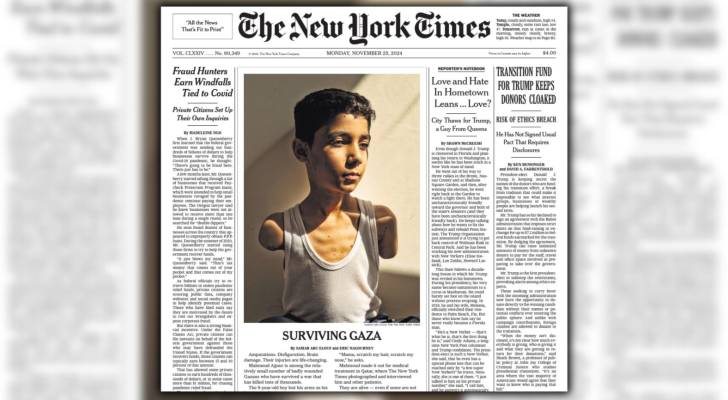"New York Times" article on Palestinian child sparks debate on 'Israeli legacy'
The New York Times recently published a deeply emotional photograph of 9-year-old Mahmoud Ajour, a Palestinian child who lost both his arms during an 'Israeli' airstrike in Gaza.
The image, which graced the newspaper’s front page under the headline "Surviving Gaza," has stirred a global outcry over the ongoing violence in Gaza, intensifying the already polarizing debate on social media, especially within Israeli Occupation.
The photograph highlights the brutal consequences of the ongoing aggression, which has claimed over 44,000 lives and left thousands more injured in Gaza. Mahmoud, one of the very few survivors of the airstrikes, is now forced to rely on his mother, Nour Ajour, for even the most basic tasks, including scratching his hair and nose. The New York Times report, detailing his journey from the wreckage to medical treatment in Qatar, illustrates the horrific toll the war has taken on innocent civilians.

The publication of Mahmoud’s photo sparked significant reactions, even on 'Israeli' Twitter, where the conversation quickly split into two camps. One group of 'Israeli' users did not favor the actions of their own government and military, with some declaring that this is the legacy 'Israel' will be remembered for, in reference to the countless war crimes committed in Gaza.
זה מעשה ידינו וחלק מההסטוריה שלנו לעולם ועד. השער של הניו יורק טיימס. pic.twitter.com/w5D8fYMUsM
— Iris Leal (@LealIris_) November 25, 2024
Other tweet questioned the morality of the Israeli Occupation Forces (IOF) after the killing of thousands of Gazan children, including 15,000 under the age of 18.
מדהים שאחרי 15,000 ילדים עזתים מתים אנשים עוד ממשיכים לברבר על המוסריות של צה"ל.
— Dina David (@DinaDavid107) November 25, 2024
On the other side, however, a different and more commonly seen narrative has taken hold with countless 'Israeli' supporters claiming that the violence against civilians in Gaza, including children, was caused by Hamas.
זה מעשה ידי החמאס וחלאות כמוך לא יצליחו לשכתב את ההיסטוריה. הניו יורק טיימס שהסתיר את השמדת יהודי אירופה ונותן שער לנוער החמאס מעניין לי ולכל מי שיש לו קצת מוח את הביצה.
— Daniel Resler (@resler_daniel) November 25, 2024
This viewpoint has been sharply challenged by others, who point out that the rise of Hamas can be traced back to 'Israeli' policies and decisions over decades. Some critics have reminded 'Israeli' users that it was Netanyahu’s government, in the 1990s, that helped fund Hamas as part of a strategy to counterbalance the Palestinian Authority. These voices argue that Netanyahu, who has been in power during many of the recent conflicts, bears significant responsibility for the current state of affairs.
The New York Times article also painted a broader picture of the devastation in Gaza, quoting survivors who are living with life-altering injuries. One statement in the piece captured the grim reality for many: "They are alive – even if some are unsure if they want to stay alive." The mention of amputations, brain injuries, and disfigurement paints a stark picture of the toll that the aggression has taken on the civilian population, which has largely been caught in the crossfire.
Mahmoud’s mother, Nour Ajour, expressed her sorrow and frustration in the interview with the New York Times, saying that her son is constantly asking for her help with tasks he can no longer perform on his own. She described how the once-vibrant boy, full of energy and life, now relies on her for basic care, a reflection of the deep personal and physical toll the war has taken on her family.
As the conflict rages on, the debate over how it should be remembered, and who should be held accountable, continues to grow.




